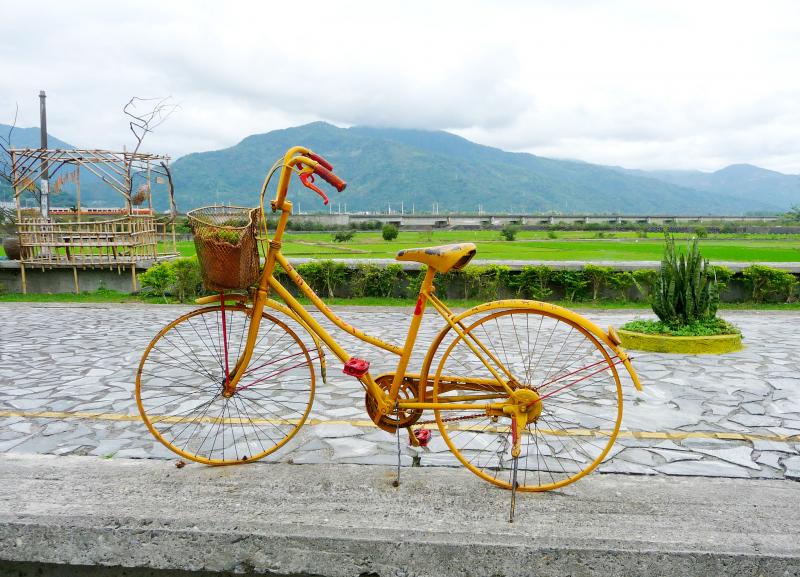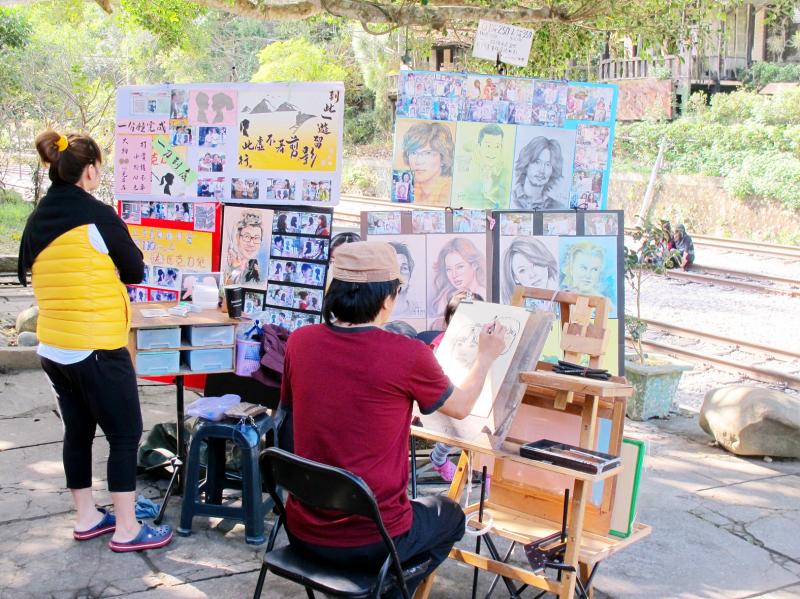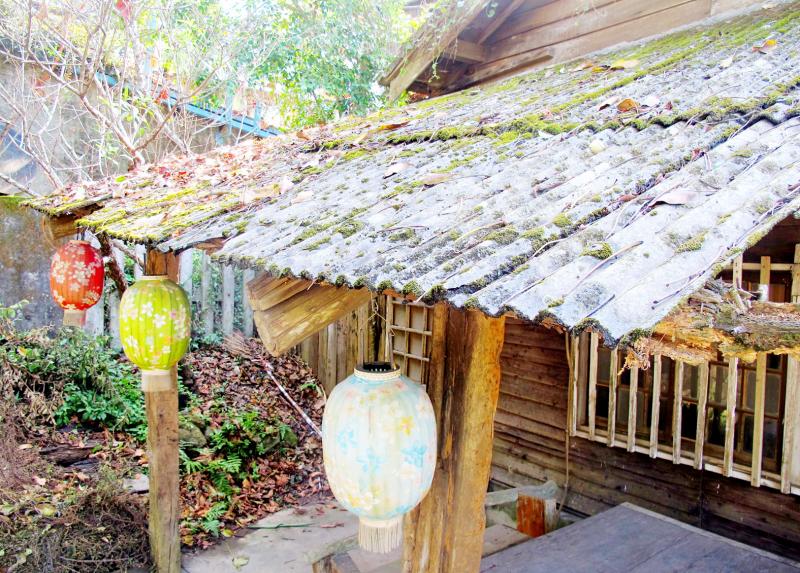For more than a century, Taiwan Railway Administration (TRA) has been connecting the north and south of the nation. Between 1912 and 1926, the rail network was expanded to the eastern counties of Hualien and Taitung.
Even though the number of people living in Taiwan has grown massively — it has more than tripled since World War II — a combination of population outflow in certain places, and a greater range of transportation options, has led to the closure of several TRA stations.
One of the most-visited retired stations is in, and named for, Kaohsiung’s Cishan District (旗山). Until the late 1970s, it was a key stop on the 39.4km-long Ciwei Branch Line (旗尾線), which was built between 1910 and 1912 to link Jioucyutang (九曲堂) on the Western Trunk Line with Ciwei Sugar Factory (旗尾糖廠) and neighboring Meinong District (美濃).

Photo: Steven Crook
The line, which carried rice and bananas as well as sugar and people, was dismantled in 1982. The station at Cishan was left to decay until 2005, when the Kaohsiung County Government listed it as a relic and funded renovation work.
Like many of the railway buildings that date from the period of Japanese rule, Cishan Station (旗山火車站) is single story and mostly made of wood. Yet its resemblance to Taiwan’s most famous colonial-era retired station, at Shengsing (勝興) in Miaoli, isn’t strong. On account of its Tudor-influenced shape, it looks more like the former Chiayi Forest Management Club (營林俱樂部) in downtown Chiayi.
There are frequent buses between Cishan and downtown Kaohsiung, and some from Tainan to Cishan.

Photo: Steven Crook
Between 1903 and 1998, what’s since become known as the Old Mountain Line (舊山線) was the highest stretch of the main north-south railroad. Shengsing Station (勝興火車站), at an altitude of 402m, is an authentic if often crowded tourist attraction. Thanks to its popularity, there’s always plenty going on around the station. Unfortunately, during normal times no public transportation goes all the way to Shengsing.
Many people in western Taiwan aspire to live in the east, but many of those who grew up in the east have moved away from their home villages and towns. Some of the TRA stations shuttered as a consequence have been repurposed into facilities for tourists.
The population of Taimali Township (太麻里鄉) in Taitung County has fallen by almost 30 percent since 1981. Duoliang Elementary School (多良國小) in the south of the township closed its doors in 1999. Duoliang Train Station (多良車站), less than 100m from the school, suspended passenger services in 2006.

Photo: Steven Crook
Few Duoliang residents want to travel by train, but lots of tourists are eager to visit the station. Its appeal is neither architecture nor nostalgia, but rather views of the Pacific Ocean.
Last year, the authorities expanded the observation deck just above the tracks. Even so, on weekends you may have to jostle for position if you hope to capture a train approaching from the south, your friends, the sea and the steep green hillside in a single picture.
Buses linking Taitung City with Dawu (大武) stop on the coast road, from which it’s a short but steep walk up to the station.
Another station on the railroad between Taitung and Kaohsiung, the one at Gujhuang (古莊) near Dawu, was downgraded to a signal installation in late 2017. The closure decision was understandable: For several years, the number of passengers boarding or disembarking here had been below 1,000 per year.
Unless you’ve a technician’s interest in the infrastructure that’s been added to the station during the electrification of the South Link Line (南迴鐵路), there’s no reason to go out of your way to Gujhuang. The two former stations I’ll talk about next are well worth visiting, however.
Unlike Duoliang and Gujhuang — where more than a dozen trains rumble through daily — the former station at Antong (安通), and what’s now called Old Dongli Station (東里舊站), were stranded when the railroad between Hualien and Taitung was rerouted some years back.
The section of track just south of Yuli (玉里) in Hualien was straightened for two reasons: So trains can travel at higher speeds; and to avoid a tectonic frontline where the Eurasian Plate is being pushed beneath the Philippine Sea Plate.
Because of this ever-shifting geological boundary, the road bridge that carries Highway 30 over the Siuguluan River (秀姑巒溪) has to be realigned every three to five years. Back when the railway ran parallel to the road, the tracks required biennial adjustment.
The former railway bridge has been converted into a river crossing for bicycles. It’s part of the Yufu Bikeway (玉富自行車道), a 9.8km-long cycling route that gets its name because it links Yuli with neighboring Fuli (富里).
As you ride or walk across, you may not notice the subtle change in gradient as you go from one tectonic plate to another. Just over 3km from central Yuli, bilingual signs mark the line of convergence; stop here if you want to get a photo with one foot on either plate.
It’s often said that getting somewhere is half the fun. That’s certainly true in this part of Taiwan. The station buildings at Antong and Old Dongli are blandly functional, but whether you make your way to them by bike, motorcycle or car, you’ll certainly enjoy the scenes of rich farmland and forest-covered mountains.
At the time of my last visit, there were no facilities or services at Antong. At Old Dongli, the official end of the bike trail, hot coffee, snacks and souvenirs were available.
If you don’t have your own vehicle, and you’re not interested in renting a bicycle, but want to hike the length of the Yufu Bikeway, be sure to bring a bottle of water, some snacks, a sunproof hat and an umbrella. Consider taking one of the buses that ply Highway 9 as far as Wujiang Elementary School (吳江國小) and from there walk north into central Yuli. Moving in this direction means you’ll be able to sit down for a meal or buy some provisions before catching a train from Yuli to your next destination.
Steven Crook has been writing about travel, culture and business in Taiwan since 1996. He is the author of Taiwan: The Bradt Travel Guide and co-author of A Culinary History of Taipei: Beyond Pork and Ponlai.

This is the year that the demographic crisis will begin to impact people’s lives. This will create pressures on treatment and hiring of foreigners. Regardless of whatever technological breakthroughs happen, the real value will come from digesting and productively applying existing technologies in new and creative ways. INTRODUCING BASIC SERVICES BREAKDOWNS At some point soon, we will begin to witness a breakdown in basic services. Initially, it will be limited and sporadic, but the frequency and newsworthiness of the incidents will only continue to accelerate dramatically in the coming years. Here in central Taiwan, many basic services are severely understaffed, and

Jan. 5 to Jan. 11 Of the more than 3,000km of sugar railway that once criss-crossed central and southern Taiwan, just 16.1km remain in operation today. By the time Dafydd Fell began photographing the network in earnest in 1994, it was already well past its heyday. The system had been significantly cut back, leaving behind abandoned stations, rusting rolling stock and crumbling facilities. This reduction continued during the five years of his documentation, adding urgency to his task. As passenger services had already ceased by then, Fell had to wait for the sugarcane harvest season each year, which typically ran from

It is a soulful folk song, filled with feeling and history: A love-stricken young man tells God about his hopes and dreams of happiness. Generations of Uighurs, the Turkic ethnic minority in China’s Xinjiang region, have played it at parties and weddings. But today, if they download it, play it or share it online, they risk ending up in prison. Besh pede, a popular Uighur folk ballad, is among dozens of Uighur-language songs that have been deemed “problematic” by Xinjiang authorities, according to a recording of a meeting held by police and other local officials in the historic city of Kashgar in

It’s a good thing that 2025 is over. Yes, I fully expect we will look back on the year with nostalgia, once we have experienced this year and 2027. Traditionally at New Years much discourse is devoted to discussing what happened the previous year. Let’s have a look at what didn’t happen. Many bad things did not happen. The People’s Republic of China (PRC) did not attack Taiwan. We didn’t have a massive, destructive earthquake or drought. We didn’t have a major human pandemic. No widespread unemployment or other destructive social events. Nothing serious was done about Taiwan’s swelling birth rate catastrophe.